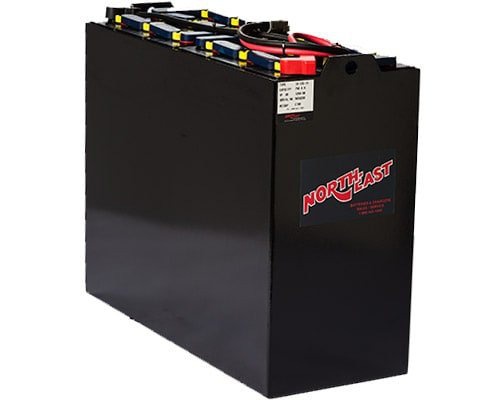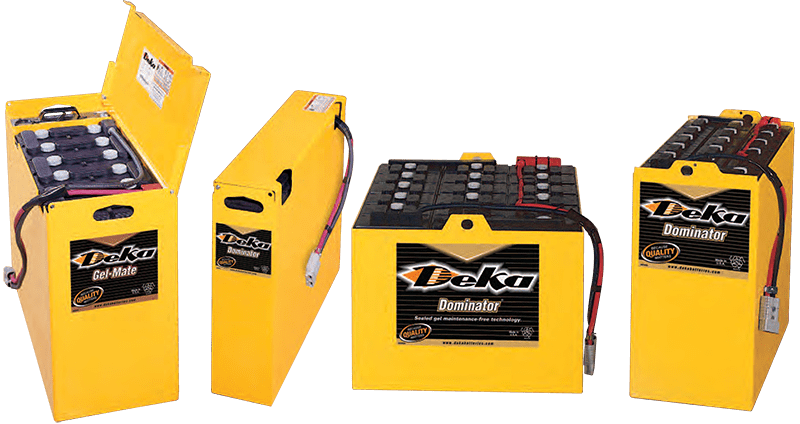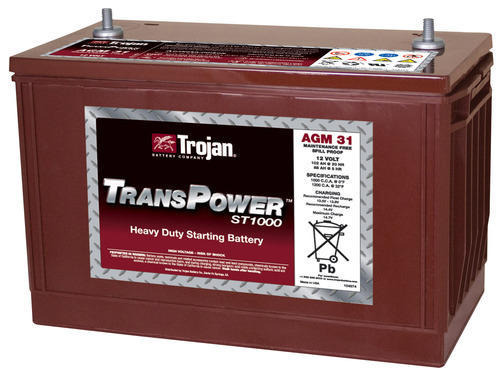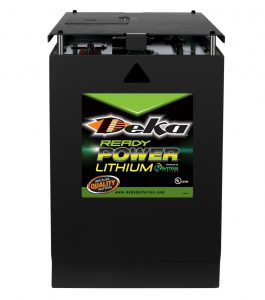Forklift batteries comes in all shapes, sizes, and types. So how will you know what types of batteries will best fit your needs? Below, we have listed out the types of batteries that are currently being used in the material handling industry, along with their pros and cons. In addition to the types of batteries available, there are specific requirements for equipment such as weight amp hours and physical shape. But that’s a discussion for another time.
Flooded Lead-Acid (Wet Cell)

The most common types of forklift batteries, Flooded Lead-Acid batteries or Wet Cell batteries are batteries containing charged plates suspended in a mixture of sulfuric acid and water. The battery works by suspending the electrolytes between 2 oppositely charged plates within the water and acid mixture. Evaporation occurs during the operating and charging process. As a result, Wet Cell batteries require more regular maintenance than other battery types to maintain top performance. This comes in the form of regularly adding water to the battery and regular cleaning, which means your business will require a specialized watering system and a trained person with extra safety equipment to ensure the correct level of water in the battery and provide maintenance for it.
The main benefit of the Wet Cell battery is its price. The battery itself costs less compared to other types of batteries, allowing businesses to have multiple batteries per forklift. If your operation requires machines to work around the clock, then multiple batteries will allow one to be recharged or serviced while the forklift is still being used.
There are a few negative aspects with Wet Cell batteries. First, you may need to purchase a special watering system, plus provide training and safety equipment for employees who will maintain the battery’s water levels. Wet Cell batteries also require regular maintenance and cleaning to keep the batteries working at optimal performance. One of the biggest negatives is the required long charging times and cool-down period prior to utilization. Typically, we recommend charging a battery for eight hours and then providing an eight-hour cooling period, leaving you with eight hours of operating time in a 24-hour period. Wet Cell batteries also need a special charging station where your team will physically remove the battery from the forklift and plug it into the charger. This means that you will need a charger for each concurrently charging battery. If you have multiple forklifts in operation, then you will need even more space for charging batteries and cooling them.
With correct maintenance and charging procedure, most Wet Cell batteries will last up to five years or 1,500 charging cycles.
Gel Cell Lead-Acid (Gel Cell)

Gel Cell Lead-Acid or just Gel Cell batteries require less maintenance than Wet Cell batteries. A gel battery is very similar to a traditional lead-acid battery, but it adds silica to the electrolyte mixture to create a gel like substance. This thickening of the electrolyte medium means that gel batteries can be installed in a variety of positions and don’t emit as many fumes. Since these batteries are sealed, they do not require a special watering system to keep the battery working.
When charging your gel battery, you’ll want to plan on giving it extra time. Slow charging cycles are common with Gel Cell batteries, but you can’t walk away and leave it charging. Since the electrolyte medium is a gel instead of a liquid, you will need to take the battery off the charger as soon as charging is complete since leaving it on could cause voids with the electrolyte which is irreversible damage.
One of the biggest complaints with Wet Cell batteries is that they are susceptible to extreme vibration and other impacts. Gel batteries have an advantage in this situation as it can absorb the impact and vibrations, making them great batteries for items such as four wheelers.
Absorbed Glass Mat (AGM)

Absorbent Glass Mat or AGM batteries are another type of sealed lead acid battery. AGM batteries work when sulfuric acid is absorbed by a very fine fiberglass mat.
AGM batteries do not require regular watering like flooded batteries. The mats themselves do not absorb and are not affected by the acidic electrolytes which allow them to work effectively without any maintenance and bring the benefit of working in a larger temperature range. The leading advantages of AGM batteries is that charging is up to five times faster than Wet Cell battery and the ability to deep cycle.
The main trade-off for an AGM battery is its low life expectancy, and each charging cycle can harm the life and performance of the battery. Manufacturers recommend discharging only up to 50% of their capacity per charging cycle, allowing the battery to last up to 1,300 cycles.
Lithium-Ion

Lithium-Ion batteries are a newer battery technology when it comes to forklifts. The pros of the lithium-ion battery are that it is relatively maintenance free because it is sealed and requires no watering or cleaning. It has a fast-charging time, requiring only 2-3 hours to fully charge with no cooldown period. You can also employ opportunity charging, which means you can plug them in during a break period for a quick charge. In fact, you can usually plug Lithium-Ion batteries straight into the wall outlet. Perhaps, most important is its increased expectancy of up to 3000 charging cycles. It does not expose your team to harmful substances such as sulfuric acid.
This convenience comes at a price, though, as lithium-ion batteries cost many times more than your typical Wet Cell battery. Also, lithium batteries are affected by the environmental temperatures in which the unit works. Freezer applications and unheated warehouses, along with our new England weather, can have a negative effect.
Conclusion
Hopefully, this will give you a better understanding of forklift battery types. Still have questions? Give us a call at (203) 239-5351 or contact us and we can recommend a forklift battery that will work for your industry.
